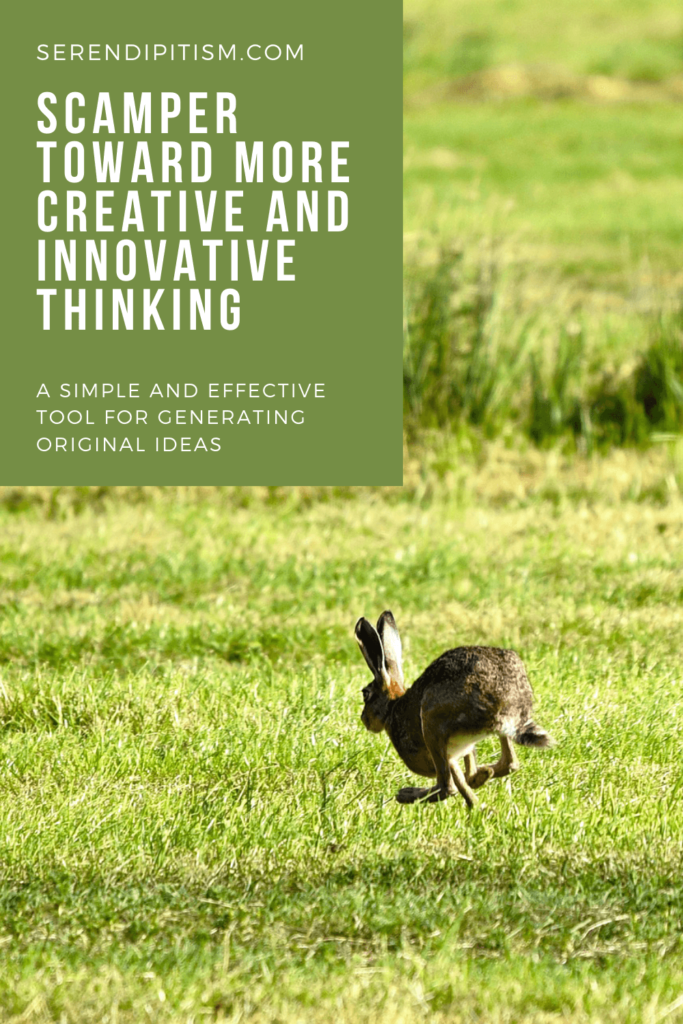
In the 1930s, one of Linus Pauling’s graduate students asked Dr. Pauling how he managed to have so many good ideas.
Pauling replied that he just had a lot of ideas, then threw away the bad ones.
Really, Pauling would later explain when recounting this exchange, having good ideas is just a matter of having a large number of ideas, and then applying some selection principle to the whole lot so that the only ideas left are good ones.
Well, sure, that’s easy for Linus Pauling to say.
But how do those of us who aren’t one of the four people in human history to have ever been awarded more than one Nobel Prize come up with enough ideas that we can just keep trashing them until only brilliant ones remain?
Fortunately, there are some techniques we can use to help us. One such method is known as SCAMPER.
The SCAMPER method
SCAMPER is a brainstorming tool that uses questions to generate multiple options.
In his 1953 book Applied Imagination, advertising executive and creativity theorist Alex Osborn (the “O” in global agency BBDO) presented an extensive list of questions that people could use to stimulate new idea generation.
Education administrator Bob Eberle later organized some of Osborn’s questions around the SCAMPER mnemonic, and in 1971 he published a book of activities and games based on the method.
In its original incarnation, SCAMPER stands for:
- Substitute
- Combine
- Adapt
- Modify
- Put to other uses
- Eliminate
- Rearrange
While developing his SCAMPER games, Eberle tested them on children as young as three years old, but also on college students and teachers.
Though Eberle initially intended the technique for use at lower age levels, it was found to be applicable to people of all age ranges and in many situations.[1]
How to use SCAMPER
In professional settings, SCAMPER is often used to help teams generate ideas for new products or services. In educational settings, it is used primarily as a group creative thinking activity.
But the technique can be used by either groups or individuals, and can be applied to improving products, services, processes, procedures, or even ourselves. It can also help to generate ideas for solving problems and overcoming anticipated obstacles.
Let’s examine the SCAMPER process.
Review the guidelines for divergent thinking
SCAMPER is a fairly uncomplicated process.
It is a divergent thinking process, however, so before getting started it’s best to review the four guidelines for divergent thinking:
- Defer judgment. Resist the urge to evaluate any ideas until the process is complete.
- Strive for quantity. The more ideas, the better.
- Freewheel. Encourage wild and unusual ideas and unique perspectives.
- Combine and build. Merge ideas to explore directions that maybe no single idea could lead you to.
Clearly state the challenge
Clearly and concisely state the challenge, and state it in a way that is likely to stimulate idea generation.
Keep it simple and specific. A challenge such as “How can we better serve our customers?” may be too broad, whereas a challenge like “How can we reduce incoming technical support call volume?” should be narrow enough to quickly generate some actionable ideas.
Regardless of the challenge, try to resolve any ambiguity in the wording before proceeding with the activity.
Select a keyword
Choose one of the keywords (substitute, combine, etc.) from the SCAMPER mnemonic.
You don’t have to proceed in the order of the acronym, and it isn’t even necessary to use every keyword.
Ask a probing question
For each keyword, ask one or more related probing questions.
You should generate your own list of questions, but there are some general questions below that can be used on their own or as a basis for creating more tailored questions.
| Substitute | Who else? What else? Where else? What other parts? What other material? |
| Combine | What elements or components could be combined? What purposes or functions could be merged? What talents or abilities could be synchronized? What procedural steps could be joined? What tools, technologies, or resources could be linked? |
| Adapt | What can be changed? What can be done differently? What can be copied from another implementation? How can this be applied in different contexts? Who could be emulated? |
| Modify | What can be increased or decreased? What features can be added or eliminated? How can the shape, form, or appearance be changed? What can be duplicated? What can be multiplied? |
| Put to other uses | What else can this be used for? Who else could use this? Where else could this be used? Can it be used for the same purpose but in different ways? Would different people tend to use it in different ways? |
| Eliminate | What can be simplified? What can be omitted or removed? Is every element or component necessary or useful? Can it be made smaller? Can the number of procedural steps be reduced? |
| Rearrange | What can be repositioned? Can roles be reversed? What can be reorganized? Can the order of procedural steps be changed? Would other layouts, patterns, or sequences work better? |
Record the options
Have the group call out their ideas for each question, and write these down. Or, if working individually, just write all of your ideas down as they come to you.
Remember, the point is to generate as many ideas as possible, so don’t worry if some ideas seem unsuitable or crazy at first.
Repeat the process
Keep cycling through the process with each question that was developed or selected for the activity.
Review the results
After cycling through all questions, evaluate the (likely long) list of generated ideas and options.
This is where you want to evaluate the suitability of ideas, and begin to combine and build on generated ideas. Ultimately, you are usually looking for approaches that are both novel and suitable.
Group or individual?
Osborn initially predicted that groups using these types of brainstorming techniques should be twice as productive at generating new ideas as similar numbers of individuals.[2]
His prediction is not supported by research, though.
While techniques such as SCAMPER do increase the number of ideas that groups generate, groups do not appear to generate more ideas than individual brainstormers. In fact, groups typically generate only half the number of ideas that would be generated by an equal number of solo brainstormers.[3]
So, even though SCAMPER may have been originally intended as a group activity, it can be used quite effectively by individuals.
How SCAMPER fuels creativity
Divergent thinking exercises such as SCAMPER enable us to generate alternatives that make it easier for us to arrange the elements in our environment in original ways.[4]
The SCAMPER technique guides us through one type of creative thinking process, and it aligns well with the major characteristics of creativity.
These characteristics include:[5]
- Fluency. Generating different relevant ideas about a topic.
- Flexibility. Shifting thinking or using different categories.
- Elaboration. Using details to work out an idea.
- Originality. Creating ideas that have not been previously proposed.
- Evaluation. Selecting and refining generated ideas.
SCAMPER is a simple divergent thinking tool that walks us through the process of generating lots of original ideas, then selecting and developing the ideas that hold the most promise.
Have more than one arrow in your quiver, though
The SCAMPER technique is a simple and effective way to generate new ideas, but it is just one tool.
If you really want to approach a problem from many creative angles, you should use SCAMPER in conjunction with a few other divergent or lateral thinking methods.
Also, while we use divergent thinking techniques to generate a large number of creative and original ideas, we use convergent thinking to evaluate these ideas and make decisions. So, the creative thinking process is ultimately a balance between divergent and convergent thinking.

